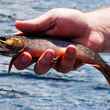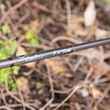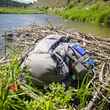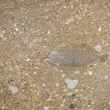As mentioned in an article last week, In Search of Cicadas, this year's periodical cicada emergence has turned out to be a highly localized affair. Still, fishermen that have sought out these big bugs have sometimes been rewarded with epic days of top water fishing. Although cicada fishing is winding down in some parts of the east coast, time to enjoy this rare opportunity still exists for many easterners, especially those in the northern range of the Brood II emergence. Should you venture out in search of cicadas, and we highly recommend that you do, make the most of it by fishing your cicadas fast.
While out for a couple days of cicada fishing this past week, both on the same stream that is characterized by long stretches of flat or slack water punctuated by relatively short riffle sections, I was struck by how literally every single one of the dozen or so other fly casters I enountered were fishing cicadas through the slack water areas. Me, on the other hand? I barely touched those areas, sticking solely to fishing foam lines and seams in the riffles and runs and only casting into slow moving water when it overlaid a deep hole that looked too good to pass up.
Don't get me wrong. Those guys were catching fish on cicadas. But I was catching a lot more. Takes in certain riffles and runs were furious, with seven or eight fish coming to hand out of one riffle in mere minutes, with just as many missed. In a number of hours, almost 30 fish came to hand, including twice as many missed takes and lots of fooling around. The guys in the slow water? Again, they were catching fish, but as a glacial pace when compared to what was going on in the faster water.
There's a good reason for all of this. In fact there are many.
More Fish Looking Up
Once the trout begin to key in on cicadas, trout everywhere are looking up. After all, it's not every day (or every 16 years in some spots, for that matter), that trout get to gorge themselves on enormous bugs that dwarf their normal meals. This being the case, you won't need to look for slower currents to find fish coming to the surface. Trout throughout the stream will be looking to take cicadas on top.
More Fish Hold in Faster Water
Trout like to hold in faster water. Particularly around the edges or seams of where faster water intersects with slower water. Why? Because these locations in the stream provide what a trout needs: food, delivered by the helpful current. If deep enough, these areas also provide cover, making these locations prime lies.
More Takes in Faster Water
This won't apply to your size 24 blue winged olive hatch, but in the case of big bug hatches like cicadas, despite the faster current and more turbid water, trout won't have any problem seeing a big meal like a cicada floating by in choppy water. When they do, they'll have less time to inspect your imitation and decide whether or not to take it. The result? More takes from trout unwilling to let a potentially big meal go floating by.
While I watched the folks fishing the slower water, I also watched the trout. The stream in question is gin clear, making it easy to spot trout in the slack water sections. As naturals would float by, trout would swim casually up to the surface, inspecting the cicadas struggling on the surface. Often, the trout would nose the cicadas several times -- while swimming alongside them for 10 or more feet -- before taking them. I hesitate to say the trout were "playing" with the cicadas before taking them, as I doubt the word "play is in a trout's vocabulary, but that's a good way of describing it.
More Aggressive Takes in Faster Water
As a result of the fact that the trout have less time to inspect and make decisions about cicadas in faster water, when they do decide to take, the takes will be more aggressive and decisive. These trout will often hook themselves as a result, leaving less work for you and fewer missed hook sets.
Once you find cicadas on the water, chances are you'll find success, and lots of it. How much, however, depends on how well you take advantage of the situation. Don't make your job harder and reduce your likelihood of suggest by giving the trout you're chasing more time and options. Give the fast water a shot, while you still can.





























Comments
Bill Dane replied on Permalink
Anyone tried fishing them in chocolate milk yet? I'd be interested if the trout are still looking up for them on those days.
Chad Shmukler replied on Permalink
Unfortunately, I havent, but hopefully some one else can speak to it.
I can say for certain that I wouldn't hesitate to fish them in off-color water, especially if it was clearing. Even if the fish were off them at first, as soon as the water cleared enough, it could all the sudden be lights out.
ginkthefly replied on Permalink
It's so hard to resist the slow water though!
All good thoughts.
Pages